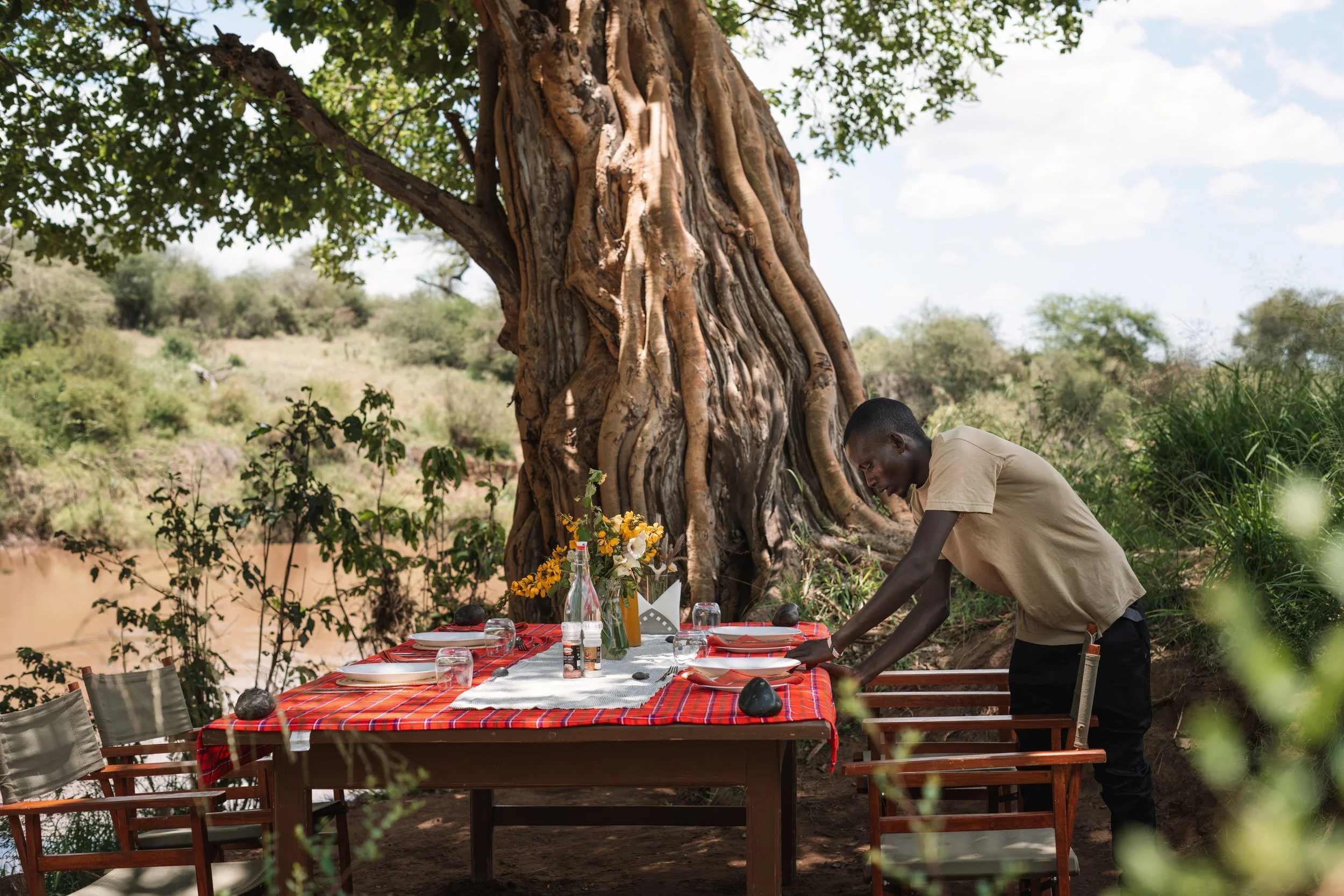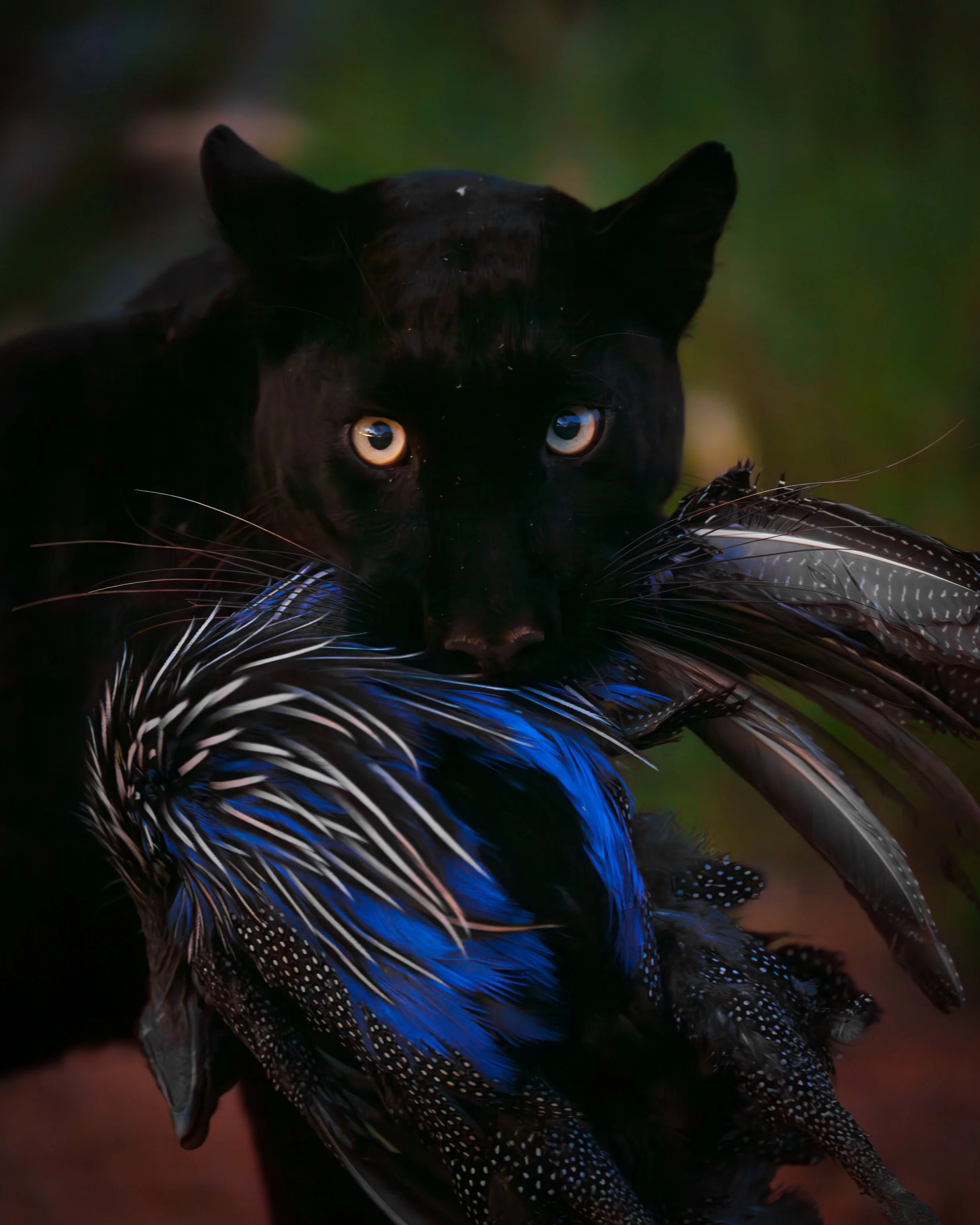
EXPEDITION
BLACK
LEOPARD
ITINERARY
Thank you for your interest in Jack Swynnerton’s 2026 “Expedition Black Leopard” Safari! Prepare for an unforgettable adventure deep into the wilds of Laikipia, Kenya, a breathtaking landscape of vast plains, rugged rocky outcrops, and meandering rivers. This extraordinary region is home to some of Africa’s most unique wildlife, including reticulated giraffes, Grevy’s zebras, gerenuk antelopes, and, if luck is on our side, the elusive and mysterious black leopard. Every moment promises incredible photographic opportunities and memories that will last a lifetime.
This safari is open to anyone who shares a passion for nature, wildlife, and adventure; everyone is welcome! For those interested in photography, Jack will provide one-on-one guidance, sharing his techniques for capturing, editing, and showcasing stunning content, along with tips and tricks for converting your content into viral social media content.
He looks forward to embarking on this extraordinary adventure with you!

The important information:
Location: Laikipia - Kenya
Expedition Dates: 26th March - 1st April 2026
Length: 6 Nights (1 night Nairobi, 5 Nights Laikipia)
Price: From $3700 per person (Single supplement is the same price)
Lodging: 1 night in Nairobi Hotel + 5 nights at Ol Gaboli Lodge
Guides: Jack Swynnerton + Driver guides
Group Size: Min 4 pax Max 6 pax
Day-By-Day Breakdown
Day 1:
On arrival at Jomo Kenyatta International Airport, clear immigration and collect your luggage. Make your way into the arrivals hall, where you will be met by your Photographic Guide, Jack Swynnerton and your driver.
Transfer to Nairobi Hotel, a drive of about half an hour.
Day 2:
This morning, you will be transferred to Wilson Airport in time to connect with a scheduled flight to Nanyuki.
Scheduled flight: Wilson Airport to Nanyuki in the A.M.
On arrival, you will be met by your driver/guide and transferred to the Camp.
Ol Gaboli is a boutique lodge tucked along the banks of the meandering Ewaso Nyiro River. With just five rooms, the lodge offers an intimate and exclusive experience, allowing us to have the entire property to ourselves. This means full access to every activity and the chance to completely immerse ourselves in everything Ol Gaboli has to offer.
Ol Gaboli means “fig tree” in Maa, the language of the Maasai, a fitting name for the lodge, which sits tucked beneath a magnificent fig tree overlooking the river. During our stay, we’ll make the most of this beautiful setting, enjoying delicious meals beneath its sweeping branches.
Jack has carefully chosen this location for its ideal proximity to a wide range of experiences, from community visits and camel rides to game drives, horse riding, and more.
Each room is spacious and inviting, featuring an en-suite bathroom and modern amenities such as Wi-Fi and convenient charging stations.
Ol Gaboli is entirely community-run and proudly stands as the only all-female, Maasai-owned lodge in Kenya, led and managed by the inspiring women of the Ol Gaboli Women’s Group.
After check-in and a short siesta, we’ll set out on an afternoon game drive to explore our new surroundings, ending the day with an unforgettable sundowner before returning to camp in time for dinner.
Overnight: Ol Gaboli Lodge
Days 2 - 6
Over the next five days, we’ll focus on capturing the remarkable wildlife, people, and landscapes of Laikipia. Each day, we’ll plan our outings to give ourselves the best chance of photographing the elusive black leopard, Giza, along with the region’s diverse wildlife. We’ll also spend time with local communities and take part in the various activities the area has to offer.
Ol Gaboli Lodge uses specially fitted 4×4 Toyota Land Cruisers designed for both comfort and photography. Each vehicle is open-sided with three rows of seats and equipped with charging sockets and bean bags for camera stability. To ensure the best photographic opportunities, every photographer will have a full row to themselves, allowing unobstructed views and shooting angles on both sides of the vehicle.
Situated in the heart of Maasai country, Ol Gaboli Lodge offers visits to local Maasai homesteads. The Maasai live in semi-permanent huts called Manyattas, traditionally built by the women using grass and cattle dung. During your visit, families will guide you around their homes (a small fee may apply). Ol Gaboli Lodge works closely with the Maasai community, providing opportunities for guests to engage meaningfully and support local initiatives.
Each evening after an action packed day we will all gather and go through footage and photos - This is also where Jack can guide you on post production and allow you to ask any questions regarding photography and videography.












Day 7: Laikipia - Nairobi
After your last game activity, you will be transferred to the airstrip in time to connect with a scheduled flight to Wilson Airport.
Scheduled flight: Nanyuki - Wilson Airport
On arrival at Wilson Airport, you will be met and transferred to Jomo Kenyatta International Airport.
Here you bid farewell to Jack, before checking in for your homeward-bound flight and depart Africa.
What to expect on this Expedition.
Join Jack on an unforgettable safari through Laikipia in northern Kenya, carefully chosen for its breathtaking landscapes and exceptional wildlife encounters. This expedition offers unparalleled opportunities to capture stunning imagery in some of the most picturesque settings.
Beyond photography, you’ll connect with like-minded adventurers, explore Kenya’s most beautiful and diverse region, immerse yourself in rich local cultures, and experience the safari of a lifetime.
Meet your photographic guide
Jack, a passionate photographer, was born in Australia, raised in the foothills of Kilimanjaro, and is now based in Nairobi, Kenya. As a fourth-generation living in East Africa, he comes from a long line of naturalists, hunters, conservationists, and pilots, making his deep connection to the wild instinctive. Jack loves an adventure and is always looking for the next best thing, having summited Kilimanjaro, bungeed jumped off Victoria Falls bridge there’s always an adventurous plan on the horizon.
His great-grandfather, C.F.M. Swynnerton, arrived in Africa in the early 1900s and became Tanganyika’s (Tanzania today) first head game warden. He played a pivotal role in eradicating the tsetse fly, helping shape the safari tourism industry as we know it today. After C.F.M.'s tragic plane accident en route to Dar es Salaam, Jack’s grandfather, Gerry Swynnerton, took over later as head of the game department in Arusha, Tanzania. Gerry was instrumental in managing wardens and protecting iconic wildlife areas such as the Serengeti and Ngorongoro Crater.
Jack was named after his great-uncle, Jack Bousfield, a legendary figure in African safaris and roamed freely where now the iconic Jack’s Camp in Botswana is situated. His family’s legacy extends even further—his grandfather, Peter Whitehead, was the lion handler for the classic film Born Free, while his great-grandfather, Alex "Fatty" Pearson, was Ernest Hemingway’s bush pilot. Pearson famously rescued Hemingway after a plane crash, a story immortalised in The Snows of Kilimanjaro, where he appears as "Compton."
Joining a safari with Jack is more than just a wildlife adventure; it’s a chance to immerse yourself in a rich history, hear legendary stories, and gain invaluable photography and social media insights.
FAQs
Photography Expedition in Kenya – FAQs
1. What makes this expedition unique?
This is more than just a safari - it's a photography-focused adventure led by Jack Swynnerton, who will take you to one of Kenya’s hidden gems, Laikipia. You'll have exclusive access to prime wildlife viewing spots, expert guidance, and opportunities to refine your photography skills in the field.
2. Do I need to be a professional photographer to join?
Not at all! This expedition is open to all skill levels, from beginners to seasoned photographers. Whether you're shooting with a DSLR, mirrorless camera, or even a smartphone, you'll receive guidance tailored to your experience.
3. What kind of photography will we focus on?
The main focus is wildlife photography, but you’ll also have opportunities for landscape, cultural, and night photography. We’ll cover techniques like composition, lighting, action shots, and post-processing tips.
4. What equipment should I bring?
A DSLR or mirrorless camera with telephoto and wide-angle lenses
Extra batteries & memory cards
A sturdy tripod
A laptop or tablet for editing (optional)
Binoculars (highly recommended for spotting wildlife) Use “jack10” for 10% discount on all Swaroski Optik products.
A detailed packing list will be provided upon booking.
5. What kind of wildlife can I expect to see?
Laikipia, Kenya, is home to an extraordinary diversity of wildlife — from reticulated giraffes, Grevy’s zebras, elephants, leopards, lions, and wild dogs, to countless other species we’ll encounter along the way, including the region’s famed black leopard.
N.B. Please note that “Giza,” the black leopard, is a wild animal, and sightings cannot be guaranteed. However, our guides will make every effort to track and locate her during your stay.
6. What’s included in the expedition package?
Expert photography guidance
All internal flights
Accommodation in Nairobi and Laikipia.
All meals
Medivac Rescue (in case of an emergency)
Private safari vehicles with ample space for photography
Park & conservation fees
Airport transfers
7. What’s not included?
International flights
Beverages at Hotels & Lodges
Visa fees
Travel insurance (highly recommended)
Personal expenses & gratuities
Extra activities such as horse riding, camel riding, community visits, etc
8. What type of accommodation can I expect?
You’ll stay in great lodges and hotels, offering comfort, great hospitality, and prime access to wildlife areas. Accommodation details will be shared upon booking.
9. How physically demanding is this expedition?
This is a relaxed safari experience with minimal physical exertion. Most photography will be done from safari vehicles, but there may be optional short walks for landscape or cultural photography.
10. How do I book, and what’s the payment process?
To secure your spot, a 30% non-refundable deposit is required, with the balance due 60 days before departure. Payment plans and cancellation policies will be outlined in your booking confirmation.
11. What should I wear?
Comfortable, neutral-coloured clothing is best for safaris. Layers are recommended for cool mornings and warm afternoons. A detailed packing guide will be provided before the trip.
12. Will there be internet and charging facilities?
Most lodges/camps have Wi-Fi, though it can be limited in remote areas. Charging facilities are available, but bringing a power bank or extra batteries is advised.
13. Can non-photographers join?
Absolutely! While the focus is on photography, the experience is immersive and enjoyable for anyone who loves wildlife and adventure.
14. What would a typical day look like?
5:00am - 5:30am - Wake up call along with a coffee
5:30am - 10:00am - Search for our next photography opportunity in the best light.
9:30am - Packed breakfast or head back to camp for a hot breakfast.
11:00am - 12:00pm - Focus on different forms of photography
12:00pm - 14:00pm - Head back to camp for a hot lunch / transfer morning photos / Editing with Jack
14:00pm - 16:00pm - Relax and get ready for afternoon shoot
16:00pm - 18:00pm - Afternoon activity maximising best light.
18:00pm - 18:30pm - Sundowner
18:30pm - 21:00pm - Dinner/ spend time around the campfire chatting about another incredible day on safari.
End of Day.








